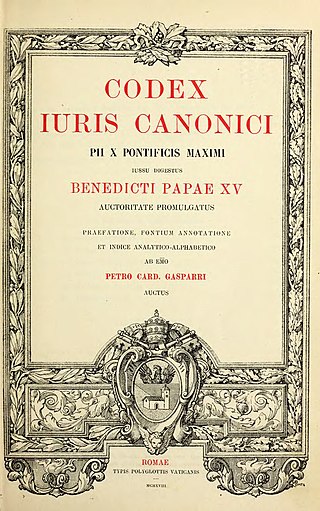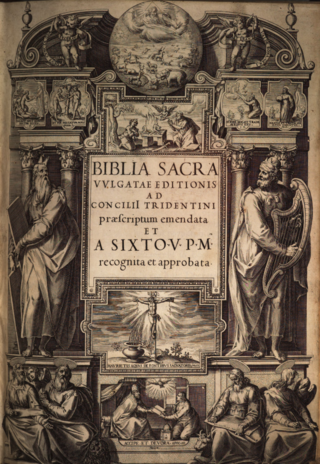Three separate canonical collections
The Liber Septimus (Latin for "Seventh book") may refer to one of three Catholic canon law collections of quite different value from a legal standpoint which are known by this title.
 |
| Part of a series on the |
| Canon law of the Catholic Church |
|---|
| |
The Liber Septimus (Latin for "Seventh book") may refer to one of three Catholic canon law collections of quite different value from a legal standpoint which are known by this title.
The Constitutiones Clementis V or Constitutiones Clementinæ are not officially known as "Liber Septimus". However, they were so designated by historians and canonists of the Middle Ages, and even on one occasion by pope John XXII in a 1321 letter to the Bishop of Strasburg. This collection was not even considered a "Liber" (book). [1]
It was officially promulgated by Clement V in a consistory held at Monteaux, near Carpentras (southern France) on 21 March 1314, and sent to the University of Orléans and the Sorbonne in Paris. The death of Clement V, occurring on 20 April following, gave rise to certain doubts as to the legal force of the compilation. Consequently, John XXII by his bull Quoniam nulla, of 25 October 1317, promulgated it again as obligatory, without making any changes in it. Johannes Andreæ compiled its commentary, or glossa ordinaria. It was not an exclusive collection, and did not abrogate the previously existing laws not incorporated in it (see Corpus Juris Canonici and Papal Decretals). [1]
The name has also been given to a canonical collection officially known as Decretales Clementis Papæ VIII. It owes the name of "Liber Septimus" to Cardinal Pinelli, prefect (president) of the special congregation appointed by Sixtus V to draw up a new ecclesiastical code, who applied this title to it in his manuscript notes; Prospero Fagnani and Benedict XIV imitated him in this, and it has retained the name. [1]
The Decretales Clementis Papæ VIII is divided into five books, subdivided into titles and chapters, and contains disciplinary and dogmatic canons of the Council of Florence, First Lateran Council and that of Trent, and apostolic constitutions of twenty-eight popes from Gregory IX to Clement VIII. [1]
It was to supply the defect of an official codification of the canon law from the date of the publication of the Constitutiones Clementinæ (1317), that Gregory XIII appointed about the year 1580 a body of cardinals to undertake the work. In 1587, Sixtus V established the special congregation to draw up a new ecclesiastical code. The printed work was submitted to Clement VIII in 1598 for his approbation, which was refused. A new revision undertaken in 1607-08 had a similar fate, the reigning pope Paul V declining to approve the Liber Septimus as the obligatory legal code of the Church. [1]
The refusals of approbation by Clement VIII and Paul V are to be attributed not to the fear of seeing the canons of the Council of Trent glossed by canonists (which was forbidden by the bull of Pius IV, Benedictus Deus , confirming the Council of Trent), but to the political situation of the day. Indeed, several states had refused to admit some of the constitutions inserted in the new collection, and the Council of Trent had not yet been accepted by the French government; it was therefore feared that the Governments would refuse to recognize the new code. It also seems a mistake to have included in the work decisions that were purely and exclusively dogmatic and as such entirely foreign to the domain of canon law. This collection, which appeared about the end of the sixteenth century, was edited by François Sentis ("Clementis Papæ VIII Decretales", Freiburg, 1870). [1]
Pierre Mathieu (Petrus Matthæus), a canonist of the sixteenth century, published in 1590, under the title of "Septimus Liber Decretalium" ('Seventh Book of Decretals'), a collection of canons arranged according to the order of the papal Decretals of Gregory IX, containing some decretals of preceding popes, especially of those from the reign of Sixtus IV (1464–71) to that of Sixtus V, in 1590. It was an entirely private collection and devoid of scientific value. Some editions of the Corpus Juris Canonici (Frankfort, 1590; Lyons 1621 and 1671; Justus Henning Boehmer's edition, Halle, 1747) contained the text of this "Liber septimus" as an appendix. [1]

Giovanni d'Andrea or Johannes Andreæ was an Italian expert in canon law. His contemporaries referred to him as iuris canonici fons et tuba. Most important among his works were extensive commentaries on all of the official collections of papal decretals, papal judgments in the form of letters to delegated judges that were at the core of canon law.
Religious law includes ethical and moral codes taught by religious traditions. Different religious systems hold sacred law in a greater or lesser degree of importance to their belief systems, with some being explicitly antinomian whereas others are nomistic or "legalistic" in nature. In particular, religions such as Judaism, Islam and the Baháʼí Faith teach the need for revealed positive law for both state and society, whereas other religions such as Christianity generally reject the idea that this is necessary or desirable and instead emphasise the eternal moral precepts of divine law over the civil, ceremonial or judicial aspects, which may have been annulled as in theologies of grace over law.
Decretals are letters of a pope that formulate decisions in ecclesiastical law of the Catholic Church.

Anastasius Germonius was an Italian Canon lawyer, diplomatist and archbishop of Tarantaise, who belonged to the family of the marquises of Ceve, in Piedmont, where he was born.
The canon law of the Catholic Church is "how the Church organizes and governs herself". It is the system of laws and ecclesiastical legal principles made and enforced by the hierarchical authorities of the Catholic Church to regulate its external organization and government and to order and direct the activities of Catholics toward the mission of the Church. It was the first modern Western legal system and is the oldest continuously functioning legal system in the West, while the unique traditions of Eastern Catholic canon law govern the 23 Eastern Catholic particular churches sui iuris.
Regulæ Juris, also spelled Regulae iuris, were legal maxims which served as jurisprudence in Roman law.
The Corpus Juris Canonici is a collection of significant sources of the Canon law of the Catholic Church that was applicable to the Latin Church. It was replaced by the 1917 Code of Canon Law which went into effect in 1918. The 1917 Code was later replaced by the 1983 Code of Canon Law, the codification of canon law currently in effect for the Latin Church.
Ecclesiastical letters are publications or announcements of the organs of Roman Catholic ecclesiastical authority, e.g. the synods, but more particularly of pope and bishops, addressed to the faithful in the form of letters.
Collections of ancient canons contain collected bodies of canon law that originated in various documents, such as papal and synodal decisions, and that can be designated by the generic term of canons.

The Decretals of Gregory IX, also collectively called the Liber extra, are a source of medieval Catholic canon law. In 1230, Pope Gregory IX ordered his chaplain and confessor, Raymond of Penyafort, a Dominican, to form a new canonical collection destined to replace the Decretum Gratiani, which was the chief collection of legal writings for the church for over 90 years. It has been said that the pope used these letters to emphasize his power over the Universal Church.

Berengar Fredol or Bérenger Frédol was a French canon lawyer and Cardinal-Bishop of Frascati.
Regular clergy, or just regulars, are clerics in the Catholic Church who follow a rule of life, and are therefore also members of religious institutes. Secular clergy are clerics who are not bound by a rule of life.
The term Extravagantes is applied to the canon law of the Roman Catholic Church, to designate some papal decretals not contained in certain canonical collections which possess a special authority. More precisely, they are not found in Gratian's Decretum or the three official collections of the Corpus Juris Canonici.

The 1917 Code of Canon Law, also referred to as the Pio-Benedictine Code, is the first official comprehensive codification of Latin canon law.

The Sixtine Vulgate or Sistine Vulgate is the edition of the Vulgate—a 4th-century Latin translation of the Bible that was written largely by Jerome—which was published in 1590, prepared by a commission on the orders of Pope Sixtus V and edited by himself. It was the first edition of the Vulgate authorised by a pope. Its official recognition was short-lived; the edition was replaced in 1592 by the Sixto-Clementine Vulgate.

The Sixto-Clementine Vulgate or Clementine Vulgate is an edition of the Latin Vulgate, the official Bible of the Roman Catholic Church. It was the second edition of the Vulgate to be formally authorized by the Catholic Church, the first being the Sixtine Vulgate. The Clementine Vulgate was promulgated in 1592 by Pope Clement VIII, hence its name. The Sixto-Clementine Vulgate was used officially in the Catholic Church until 1979, when the Nova Vulgata was promulgated by Pope John Paul II. The Clementine Vulgate is still in use in the 1962 missal and breviary of the Catholic Church.
Jus antiquum is a period in the legal history of the Catholic Church, spanning from the beginning of the church to the Decretum of Gratian, i.e. from A.D. 33 to around 1150. In the first 10 centuries of the church, there was a great proliferation of canonical collections, mostly assembled by private individuals and not by church authority as such.
The Catholic Church utilizes the oldest continuously functioning legal system in the West, much later than Roman law but predating the evolution of modern European civil law traditions. The history of Latin canon law can be divided into four periods: the jus antiquum, the jus novum, the jus novissimum and the Code of Canon Law. In relation to the Code, history can be divided into the jus vetus and the jus novum. Eastern canon law developed separately.
The following outline is provided as an overview of and topical guide to the canon law of the Catholic Church:

The Quinque compilationes antiquae is a set of five collections of twelfth and thirteenth century decretals totalling between 1,971 and 2,139 chapters.